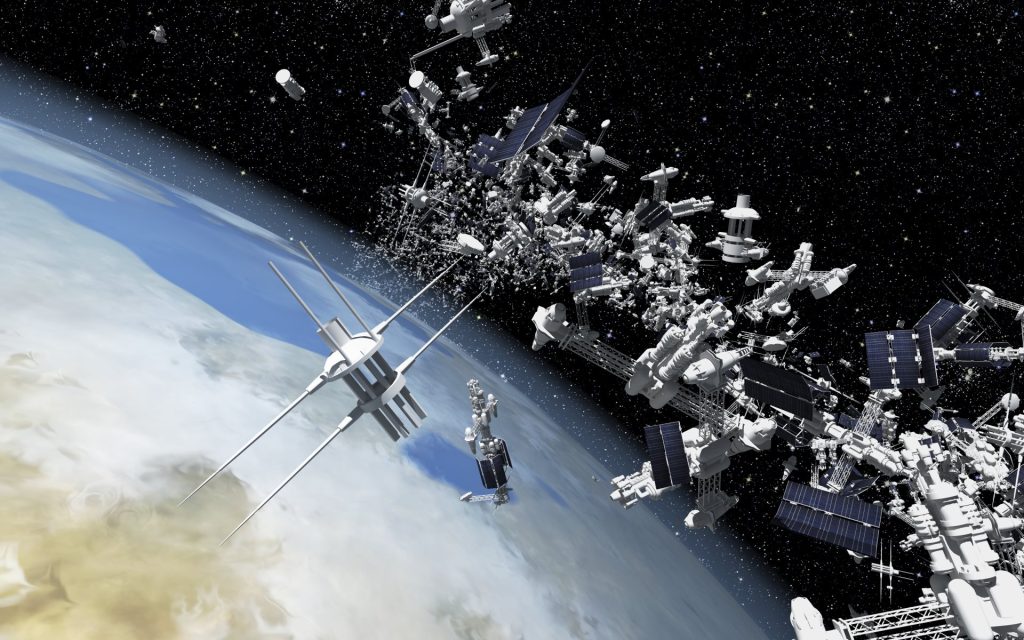Space Debris: A Growing Threat to Earth’s Orbit

The early hours of last Good Friday witnessed a luminous trail streaking across the sky of the Spanish Mediterranean coast, disappearing into the marine horizon. Following the initial astonishment, military commanders responsible for overseeing airspace reported it as a “grazing meteoroid,” ruling out the possibilities of a ballistic missile or a Starlink satellite, as initially speculated. This incident underscored the importance of controlling space debris orbiting the Earth.
According to the latest data from the European Space Agency (ESA), approximately 11,500 tons of space objects are swiftly moving above our heads. This debris cloud comprises a million fragments ranging from one to ten centimeters and 36,500 larger bodies. However, not all debris is cataloged and tracked by the databases established since the dawn of the space race (ESA monitors around 35,150 objects).
Space debris, ranging from car-sized chunks to paint flecks, poses a significant threat due to their velocity, exceeding 28,000 kilometers per hour, turning them into high-speed projectiles. Efrén Díaz, technology and space law expert at Bufete Mas y Calvet and Secretary-General of the Spanish Association of Aeronautical and Space Law (AEDAE), emphasizes this danger. At such speeds, a sphere just over a centimeter in diameter could cause damage equivalent to a car traveling at 50 km/h.
Today, the primary threat targets satellites and stations orbiting in low Earth orbit (LEO), ranging from approximately 150 to 2,000 kilometers in altitude. This region is becoming increasingly crowded, particularly due to endeavors like Elon Musk’s Starlink satellites, aimed at providing global internet coverage. In 2023 alone, over 2,000 satellites were launched, with the majority being Starlink satellites. With more vehicles in orbit, space highways become more perilous. Víctor Barrio, senior associate at Hogan Lovells and vice president of AEDAE, notes frequent maneuvers by satellites and the International Space Station (ISS) to avoid collisions, thanks to alerts from Space Surveillance and Tracking (SST) services.
While experts refrain from alarmism, they warn of continuous bombardment of space debris on the planet. Although the atmosphere manages to eliminate most debris, some objects penetrate it, posing risks of impact with the Earth’s surface. For instance, NASA is investigating a report from a Florida resident claiming that debris from ISS batteries crashed into their house roof on March 8.
The 1972 Convention on International Liability for Damage Caused by Space Objects stipulates that the launching state or “those who have participated substantially in their manufacture” are responsible. Barrio interprets this rule, noting its strict application, especially concerning damages on Earth, where culpability isn’t required. In cases like the one in Florida, citizens cannot act independently; instead, states seek recourse through diplomatic channels. “The procedure is clear,” Barrio asserts.
However, in practice, pursuing claims for space debris incidents can be complex due to various factors hindering evidence collection and liability determination. Díaz highlights challenges such as limited witnesses in space and difficulty identifying responsible parties, especially for unregistered objects. Once these hurdles are overcome, jurisdiction and applicable laws must be established, particularly for international launches. Moreover, securing compensation can be elusive if the responsible party refuses to indemnify.
Chaos in Air Traffic
Another paradigmatic incident was the temporary closure of Spanish airspace in 2022 due to uncontrolled re-entry of debris from a Chinese rocket, causing flight delays. Under European legislation, airlines aren’t obliged to compensate for such extraordinary events. While Spain’s invocation of the convention may be contested, as it necessitates physical damage, Barrio advocates for a broader interpretation accommodating increasingly common extraordinary situations.
Regulatory efforts now focus on fostering a safer and more sustainable space environment. Juan Carlos Cortés, director of programs and industry at the Spanish Space Agency (AEE), suggests holding companies and governmental entities accountable for space debris reduction. He cites the ESA’s “Zero Debris” plan for 2030 as an example. AEE is crafting specific guidelines to establish safety, liability, and coordination standards for satellite launch and maintenance by private entities.
Several companies are developing technologies to manage satellite lifespan and remove space debris. Recommendations include retiring obsolete satellites within five years. One such company is the Spanish firm GMV, specializing in tracking systems to ensure operational safety. Miguel Ángel Molina, Deputy General Director, explains their work on “docking bays” to deorbit obsolete satellites, akin to car tow hitch systems. These efforts aim to enable continued space exploration and ensure future generations can behold a sky clear of debris.
Implementing a Debris Levy
The notion of imposing a debris levy on countries or responsible entities to fund space cleanup has been proposed multiple times. Efrén Díaz of Bufete Mas y Calvet views this idea as challenging to implement due to the need for international agreement, particularly with polarized geopolitical powers. “It’s an attractive idea facing significant challenges like identifying responsible parties, given the variety of actors involved in space activities,” Díaz remarks.
Conclusion
Space debris poses a growing threat to Earth’s orbit, necessitating concerted global efforts to mitigate risks and ensure the sustainability of space activities. From regulatory initiatives to technological innovations, addressing this issue requires collaboration across sectors and nations. With careful planning and proactive measures, we can safeguard both space exploration endeavors and our planet’s safety.
